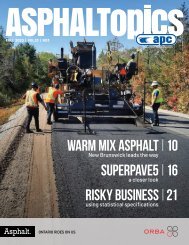ASPHALTopcs | Summer 2017 | VOL 30 | NO 2
Create successful ePaper yourself
Turn your PDF publications into a flip-book with our unique Google optimized e-Paper software.
In 2015, Conestoga College purchased<br />
an asphalt paver to incorporate into<br />
its HEO program.<br />
want to work the long hours and they look somewhere else.<br />
Marketing the industry and training people is an investment<br />
and maintaining them is critical. As an industry, we need to<br />
focus on mentorship and fostering loyalty, and that is done<br />
through providing a safe work environment, competitive<br />
wages and benefits and job security.”<br />
Jeremy Andrews, 2014 Roads Scholarship recipient<br />
and Contestoga College graduate, agrees that industry<br />
mentorship will go a long way in recruiting and maintaining<br />
a skilled and loyal workforce. Upon graduating from<br />
Conestoga’s Heavy Equipment Operator Program,<br />
Mr. Andrews joined Capital Paving in Guelph and is<br />
a heavy equipment operator.<br />
“Young people who are considering joining the industry<br />
are facing a challenging situation,” says Mr. Andrews.<br />
“They can either join an apprenticeship program, which<br />
is quite expensive, or just show up on a job site and do<br />
manual labour for the next five years until they are actually<br />
put on a piece of equipment. So, if you don’t have the<br />
money to do the apprenticeship program, you can get<br />
discouraged pretty fast.<br />
“Even if you have gone through a program, it can still be<br />
challenging to get to do the work that you went to school<br />
for. More mentorship programs would be helpful for those<br />
who come on as manual labour on a crew and for those who<br />
come through a program so that they can gain hands-on<br />
experience and know that they will be able to do the work<br />
they want to do.”<br />
In addition to industry investing in mentorship programs, Reg<br />
Legere, Conestoga Professor of Trades and Apprenticeship<br />
for the Heavy Equipment Operator Program, says that it is<br />
important to educate students on what they can expect in<br />
the real world once they get into the job market. “Those<br />
students who are just coming into the industry have to<br />
understand that starting out, they are going to have to pay<br />
their dues and may have to start out on the rake; really this<br />
helps to foster respect and an understanding of the entire<br />
paving process. At the same time, on-the-job mentors will<br />
greatly help to get “green” workers polished and ready to<br />
take on more responsibility,” explains Mr. Legere.<br />
Conestoga College is one of the few colleges that has<br />
a paver on site at its Guelph campus facility, and has<br />
incorporated asphalt paving into its curriculum, thanks in<br />
part to its partnership with the OAPC. “With the Roads<br />
Scholars and Scholarship Program and having OAPC come<br />
out to present to students and have that one-on-one contact,<br />
the school sees that the industry is an invested partner, and<br />
that is how we were able to bring in the paver in 2015 and<br />
include asphalt paving into the program,” says Mr. Legere.<br />
The symbiotic partnership between the colleges and<br />
industry not only helps to recruit skilled workers into the<br />
industry, but also benefits industry from a quality standpoint,<br />
according to OAPC Executive Director, Vince Aurilio.<br />
We need to focus on mentorship and<br />
fostering loyalty through providing a<br />
safe work environment, competitive<br />
wages and benefits and job security.<br />
- Ritchie<br />
“Teaching best practices in asphalt paving in the schools is<br />
a grass roots effort that benefits everyone,” says Mr. Aurilio.<br />
“As we pass this knowledge on to the upcoming workforce,<br />
they will be better equipped to help raise the bar in building<br />
quality asphalt pavements.”<br />
Better marketing of the industry, investment in mentoring<br />
programs and industry/academic collaboration is a partial<br />
key to resolving the skilled labour shortage. However, that<br />
shortage is also due to Canada’s population demographics.<br />
According to Statistics Canada, the nation’s population<br />
growth by birth rate began to decline in the late 1960s<br />
and by 1976, the fertility rate had fallen to fewer than<br />
1.8 children per woman and remains consistent today.<br />
Since 1999, population growth has consistently been<br />
driven by immigration. Approximately two-thirds of current<br />
population growth is the result of migratory increase, while<br />
natural increase accounts for the remaining one-third.<br />
“Because of our demographics, there are simply fewer<br />
people graduating from high school,” says Stephen Speers,<br />
Conestoga Chair of School of Trades and Apprenticeship.<br />
28 OAPC | ASPHALTOPICS

















